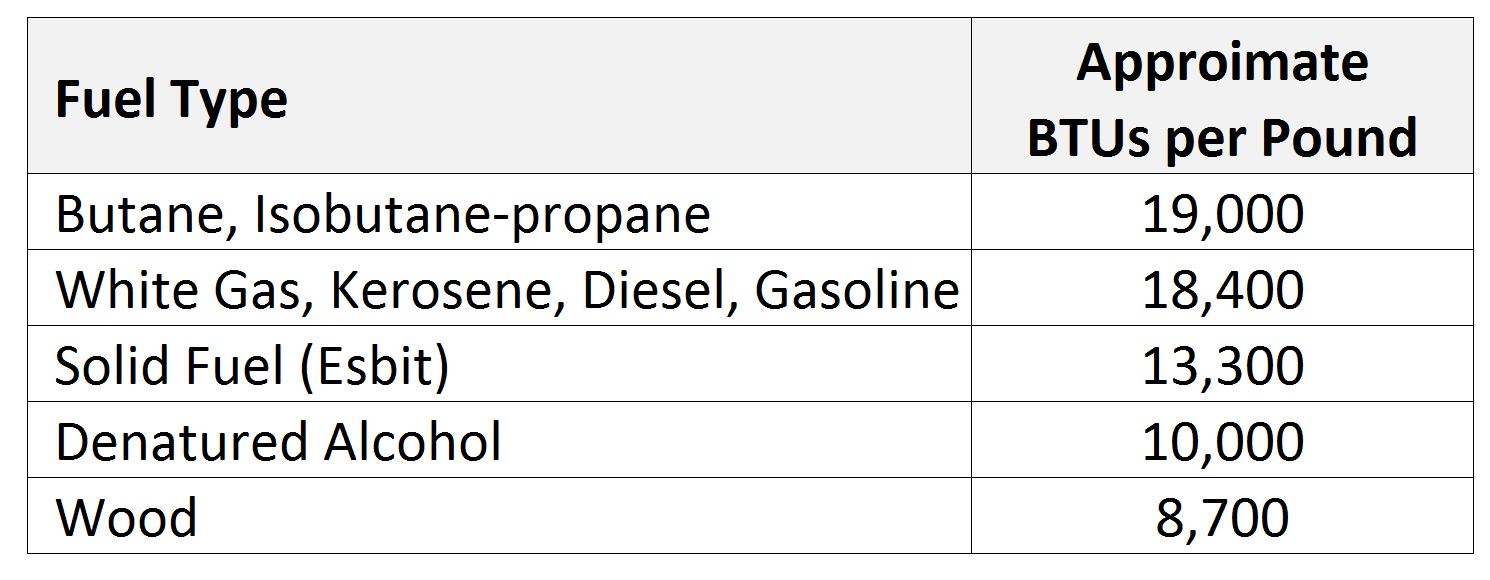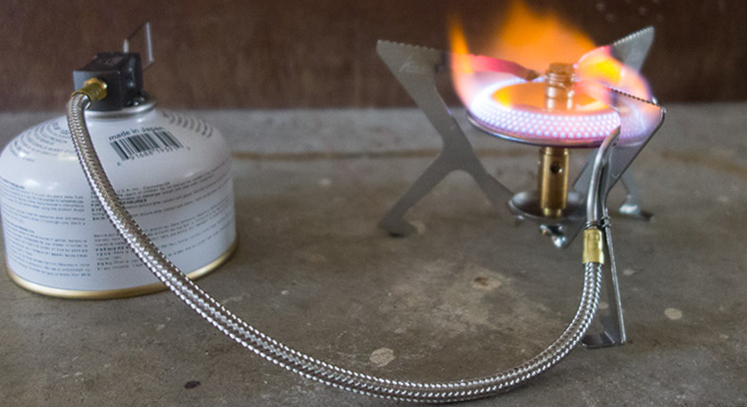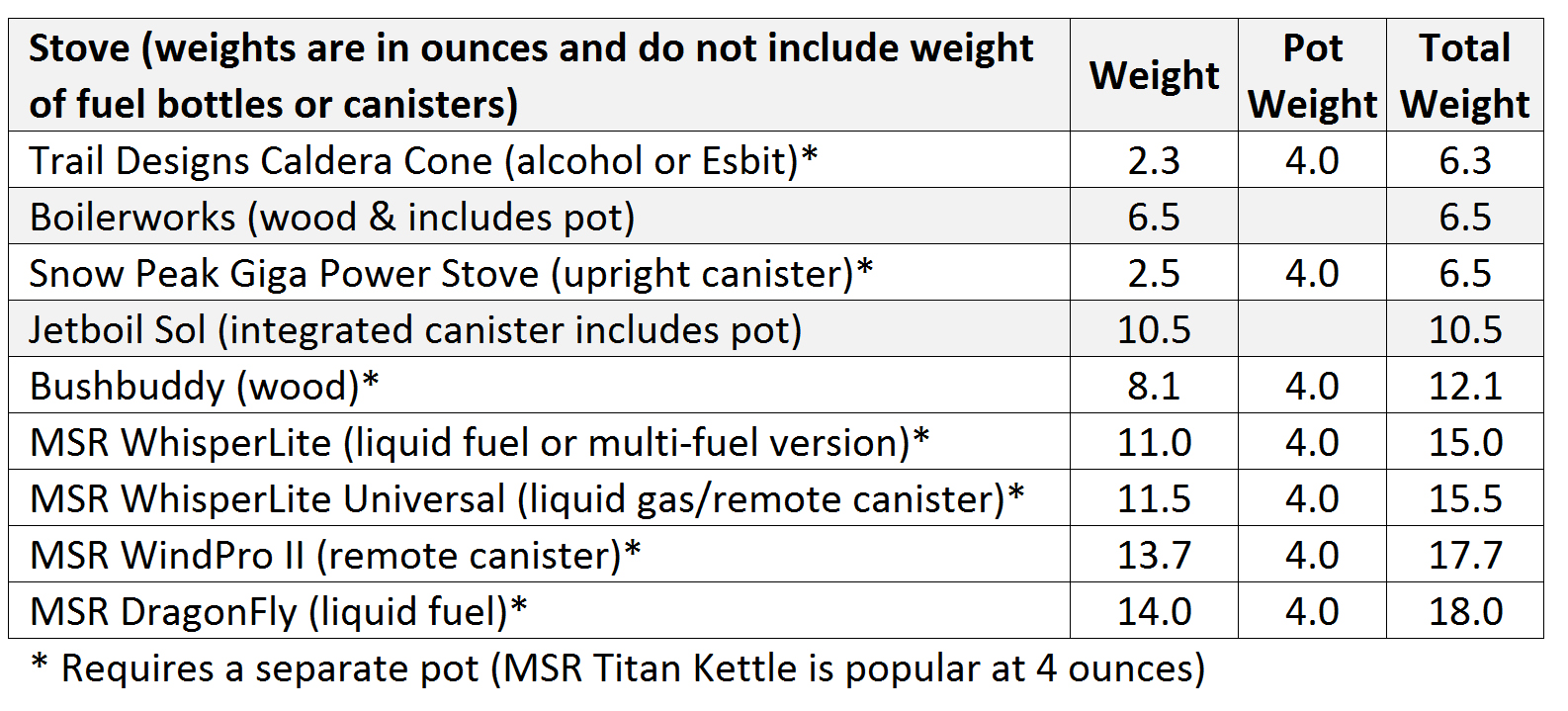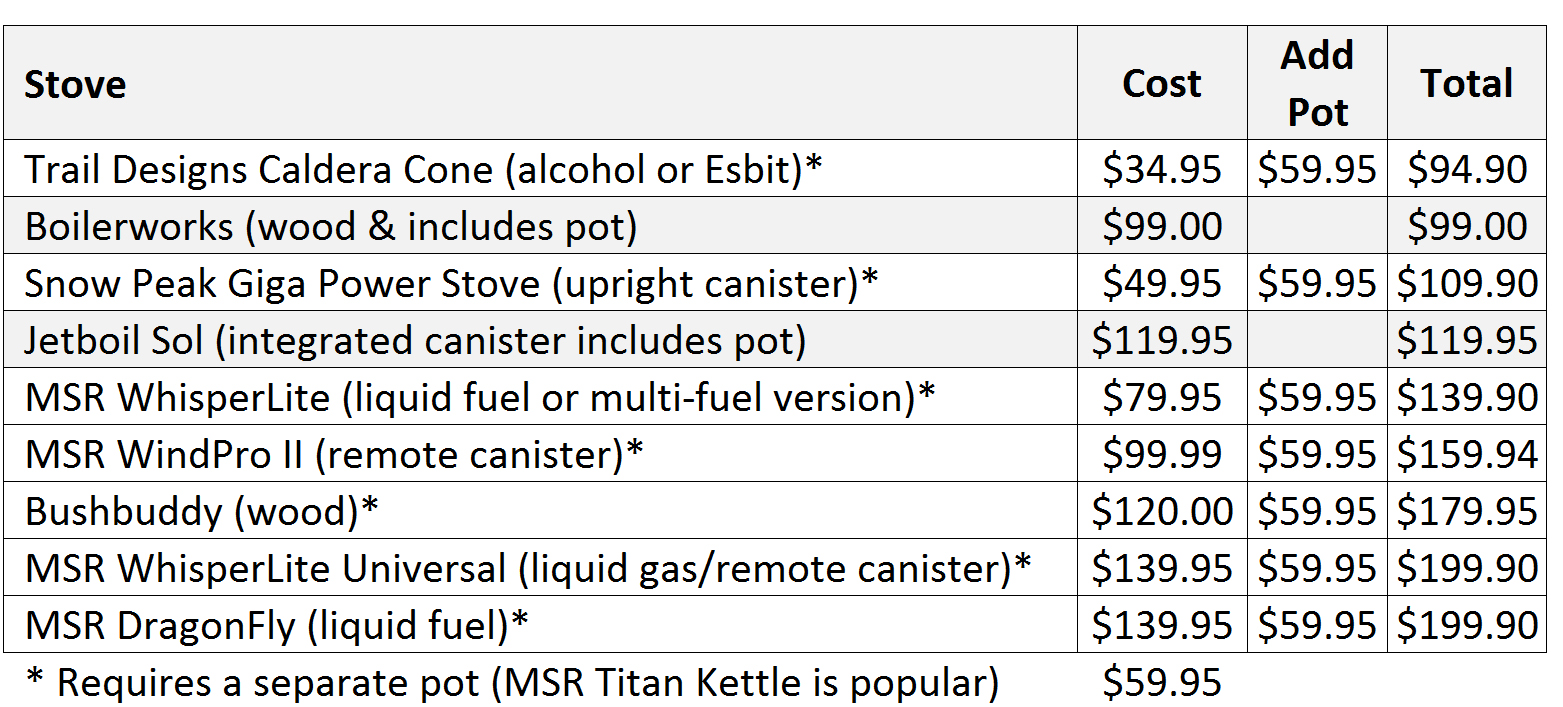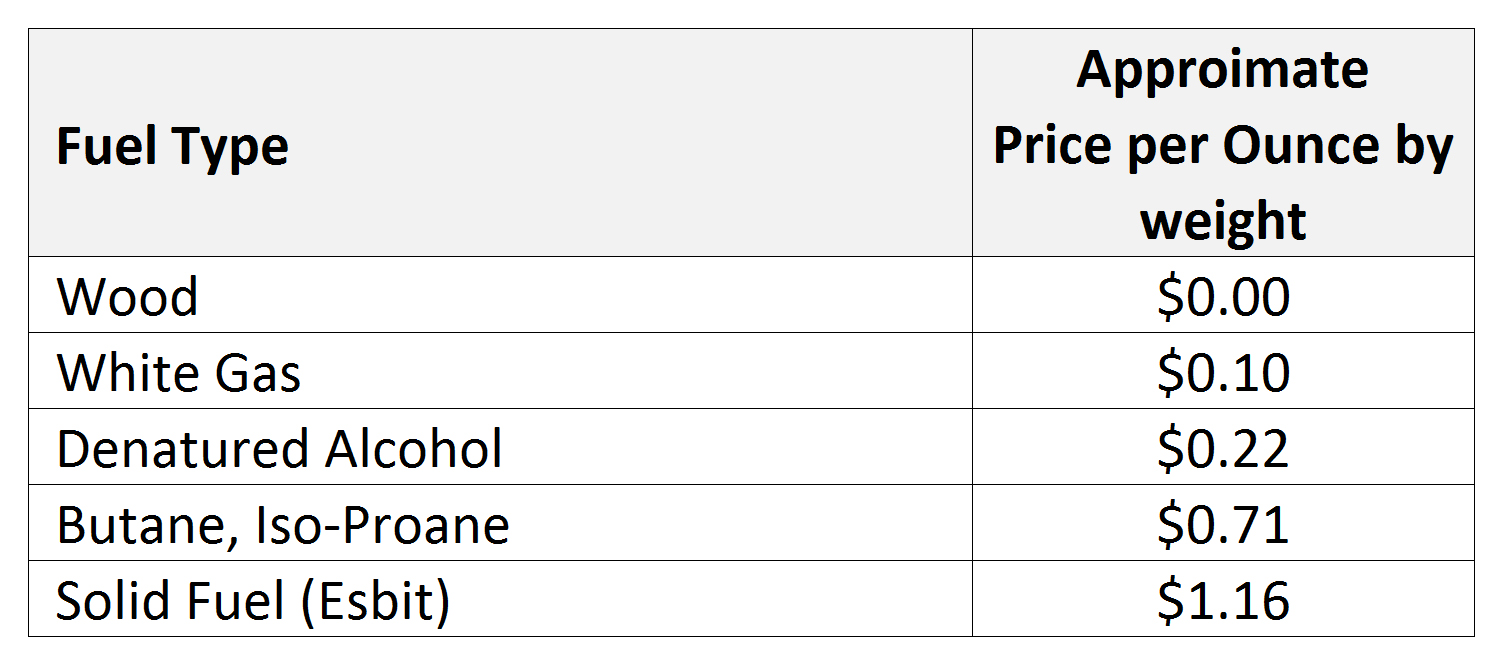I bought my first real backpacking stove in early 1972, a Svea 123 that uses white gas. Before that I cooked on wood fires and a U.S. Military canteen stove. I used wood, solid fuel and alcohol in the canteen stove. Sometime in the 70’s I bought a butane canister stove.
Today, 40 years later, the same kinds of stoves are the options available to the backpacker. There have been some minor improvements in stove efficiency and weight reduction, but nothing revolutionary. Since there have been so few advances in stove design, I am often perplexed when I see backpackers constantly buying, testing, and spending so much time playing with stoves. Seems like they would be better served by buying a couple proven stoves, and with all the time saved by no longer playing with stoves, the time could be used to actually go backpacking.
So I thought I would save everyone some time by reviewing some stoves so we can end The Great Stove Debate and get out into the wilderness.
I have several stoves. Some are old ones I bought decades ago, and a few newer ones I use on most trips these days. I do use different stoves for different conditions. But if one isn’t concerned with owning the newest or lightest stove on the market, or having the lightest spreadsheet gear list, a backpacker can get by with a single stove — usually a white gas stove or a gas canister stove that can be used in sub-freezing temperatures.
In the following discussions below, I am not going to bore you with boil times and other minutia, just high level information and a quick overview of some popular options. If you just want to know what I recommend or use, simply scroll to the bottom. That will save you even more time that could be better used for constructive activities, such as backpacking.
FUEL TYPES
There are 5 basic fuel types and a 6th option
- Wood
- White gas or similar liquid fuels
- Isobutane-propane or similar fuels that come in a pressurized canister
- Alcohol
- Solid fuels (Esbit is the most popular)
- No fuel (just bring no-cook food)
Each of the fuel options have pros and cons. Aside from how efficient the stove and fuel options are, the backpacker also needs to take fuel availability and cost into consideration.
BTU’s
British Thermal Units, for our less than technical conversation here; measures how much energy is in a pound of fuel. The higher the BTU’s the more efficient the fuel is – however stove design can reduce the potential energy of each fuel. But it is close enough for us.
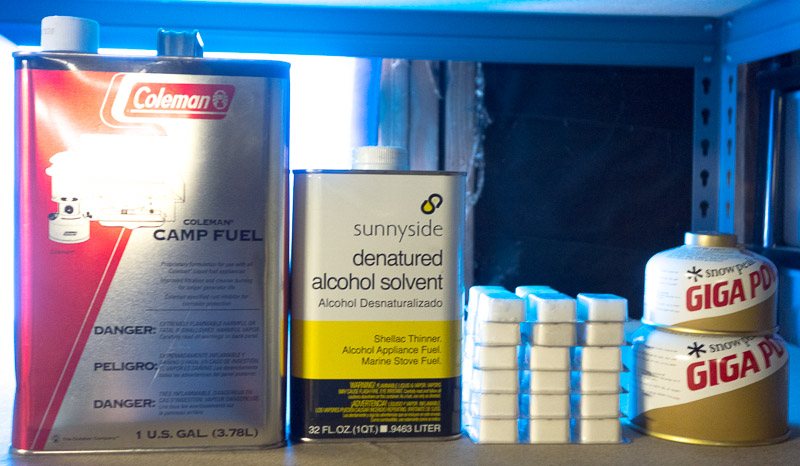
The BTU’s for butane, isobutane/propane, white gas, kerosene, diesel, gasoline, and denatured alcohol are averages because how fuels are blended vary among manufacturers. Wood varies as to type and resin content. But this gives us a good picture of the fuel options.
Many people are surprised to find out that the butane/propane mixes have the highest BTU’s.
WOOD
In my early backpacking days all my cooking was done over a campfire. Wood fires leave a sooty deposit on pots, smoke gets in your eyes, you have to locate wood (sometimes difficult in wet weather), some jurisdictions do not allow wood fires, and wood fires are sometimes not appropriate for the environment.
Although somewhat heavy compared to some backpacking stove options, there are several compact wood stoves available on the market; two well known brands are the Bushbuddy and the Backcountry Boiler.
Depending upon the configuration, the Bushbuddy weighs between 5.1 and 6.5 ounces; the Backcountry Boiler between 6.5 and 8 ounces. I have not used either because I hate to cook with wood.
A final option is one of the Trail Designs Ti-Tri systems that burn wood, alcohol, or Esbit solid fuel.
All three of these systems are fairly lightweight. But for me, I will state it again, I hate cooking with wood.
Summary
Wood has the lowest BTU’s of any of the 5 main fuel types — significantly less. The soot on pots can make a mess of your other gear. Smoke sucks and stinks up your clothes. Dry wood can be hard to find at times, requiring wood cutting tools. It is often banned in many areas. It is the cheapest fuel (free).
LIQUID
The most popular liquid fuel in the US is white gas. Some liquid stoves can also burn kerosene, aviation jet fuel, diesel, and even unleaded gasoline. The most popular liquid stove of all time is probably the Svea 123. It is reliable and requires virtually no maintenance, but is somewhat heavy by today’s standards. In the early 1980’s Mountain Safety Research (MSR) introduced the WhisperLite stove. It is still one of the most popular liquid stoves on the market.
MSR WhisperLite
The classic WhisperLite stove weighs 11 ounces without a fuel bottle or a pot. A special fuel bottle must be connected to the stove and is pressurized with a pump. Getting the stove to simmer is a bit of a chore, but can be done with practice.
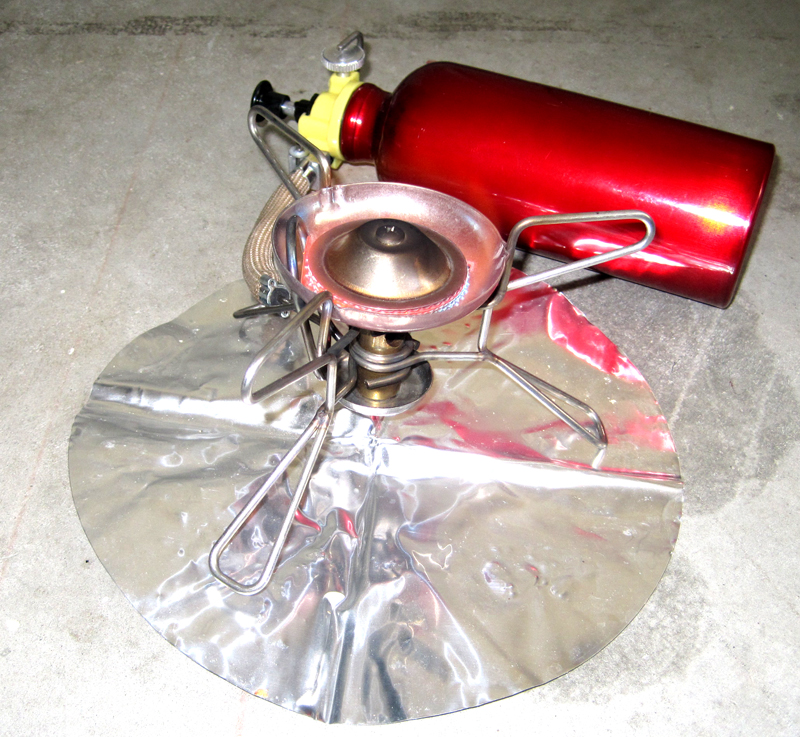
MSR WhisperLite International
Basically the same stove as the WhisperLite, but by changing the jet it can burn multiple liquid fuels. Weight is 11 ounces.
MSR WhisperLite Universal
Not only can this stove burn multiple types of liquid fuels, it can also connect to a standard isobutane – propane canister. Weight is 11.5 ounces.
MSR Dragonfly
This stove simmers extremely well and can handle large pots. Matched to a 1.5 or 2 liter pot is great for melting snow. Weight is 14 ounces.
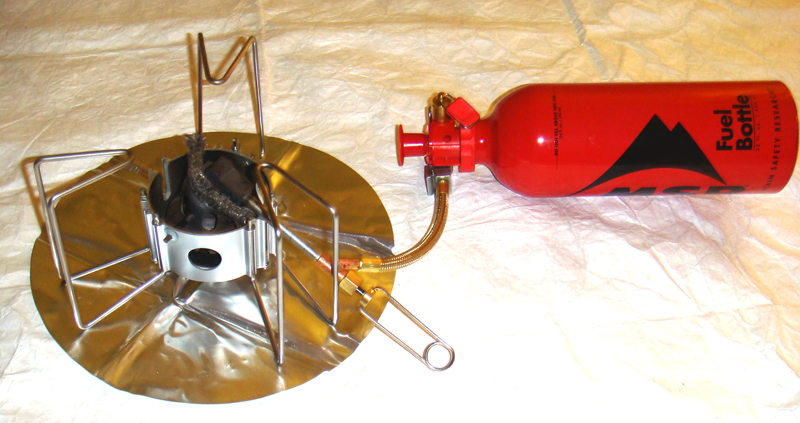
Summary
For extreme conditions many experienced backpackers opt for a liquid fuel stove. They are reliable and efficient for melting snow. Liquid stoves require annual maintenance and have a tendency to flare up when lighting them. Fuel cost is low. These are the heaviest stoves, even without the required special fuel bottle that is additional weight.
Most stoves need a windscreen. All the MSR stoves (to include the remote canister stoves) include an aluminum base and windscreen. These can be purchased separately and I have bought many of them over the years.
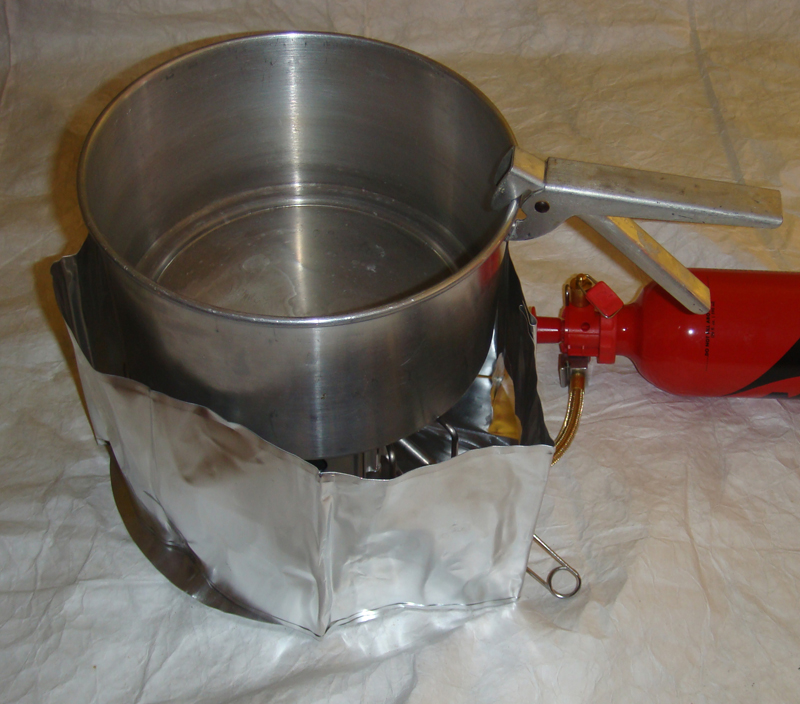
CANISTER STOVES
In the early 70’s the butane canister stove appeared on the market. The first commercially available models were sold by both Hank Roberts and Gerry (they were identical). Most canister stoves do poorly in cold weather, although the Hank Roberts and Gerry stoves (among others) used special canisters that fed liquid butane to the stove burner and were much better in cold weather than the vapor fedd models on the market.
Canister vapor or liquid fed stoves
Butane canister stoves have mostly been replaced with a fuel mixture of isobutane-propane, which works much better in colder weather. However, once the temperature gets much below freezing, the stoves work poorly. This is because most isobutane – propane stoves feed vapor to the stove burner and below freezing the vapor freezes. An exception is canister stoves that can be operated with the canister inverted which then feeds liquid to the stove.
Most of these canister stoves are convenient to operate and simmer well. Canisters add weight to your kit, must be properly disposed, and the fuel is expensive compared to other options.
TOP MOUNTED CANISTER STOVES
These stoves connect to the top of the canister. Simple to set up and very efficient, these stoves enjoy great popularity in the backcountry. Their weakness is poor operation in windy conditions. For the most part, you cannot or should not use a windscreen with a canister stove. Windscreens can overheat the canister and result in an explosion. An exception is the Snow Peak Giga Power stove. Snow Peak sells a windscreen that weighs almost as much the stove (2 ounces) and is not that effective in wind. Many people have built special windscreens for top mounted stoves with success. Just keep in mind you really need to know what you are doing and almost all stove manufacturers recommend not using a windscreen.
I like the Snow Peak Giga Power stove. It is stable, efficient, easy to use, and produces very little carbon monoxide compared to the competition. I bought mine in 2008 and have not had a single problem with it.

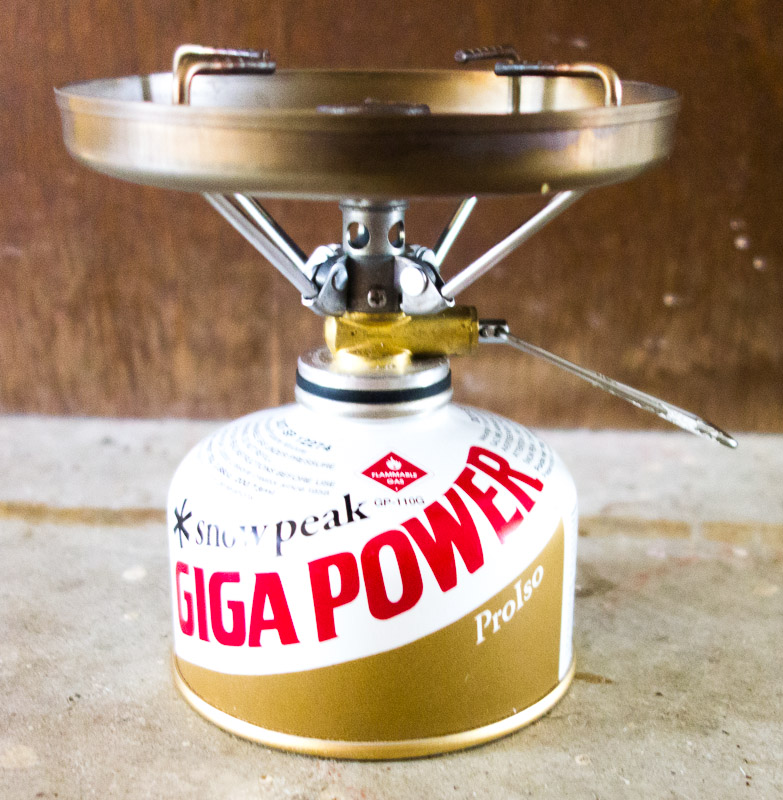
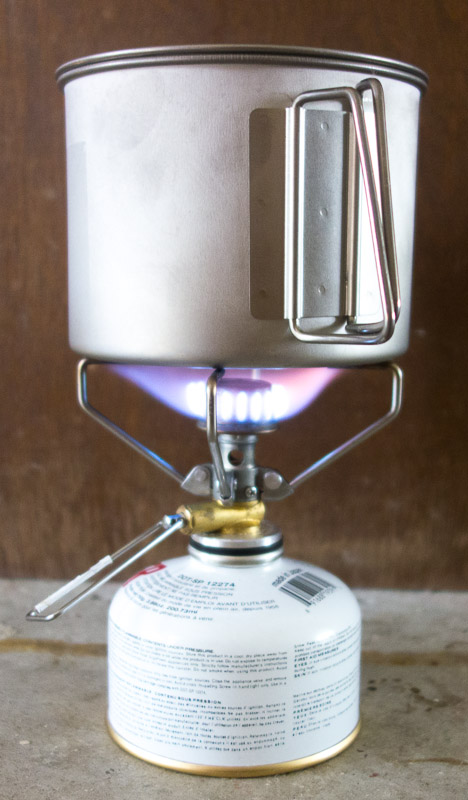
Summary
Extremely light (some models weigh less than 2 ounces). Easy to operate and cook on. Poor in wind and the cost of fuel is high. Hard to determine how much fuel is in a partially used canister when on the trail.
Beware of the cheap knock-offs sold on eBay and Amazon. Canister stoves have the potential to be extremely dangerous if the canister overheats. It is stupid to jeopardize your life to save a few dollars. Spend the money for a well known brand.
REMOTE CANISTER STOVES
To solve the wind problem (at the expense of additional weight) some canister stoves come with a hose to connect the canister remotely, which allows the use of a windscreen around the stove because the canister cannot overheat. One of the first remote canister stoves on the market was the Camping Gaz Tristar.
Caution: canisters should not be inverted on a remote canister stove unless the stove is designed to operate with an inverted canister.
Some remote canister stoves are designed to work with the canister inverted, supplying liquid fuel to the stove. These inverted canister stoves, for the most part, work as well as the liquid gas stoves since the BTU’s of white gas and isobutane – propane is almost the same. In extreme temperatures white gas should be the stove of choice.
MSR Windpro
The WindPro series of stoves are a WhisperLite stove designed to operate on canister fuel.
A few years ago I purchased a WindPro, which technically was not designed to use an inverted canister. However the stove burner assembly included a generator that did allow it to safely use an inverted canister. The only problem with the WindPro is the connecting hose between the canister and stove was not flexible enough to invert the canister without using something like a rock to hold the canister in place.
MSR Windpro II
I suspect when MSR saw so many people using the first WindPro with inverted canisters, they decided to make a couple changes so the stove could be easily be used with an inverted canister. The biggest change was a hose that allowed the canister to be used upright or inverted. When it hit the market I gave my old WindPro to a friend and bought the new version.
I have used the WindPro stoves in below freezing temperatures with good success. But for temperatures below 20F, I usually take my MSR Dragonfly when I need to melt a lot of snow. Some pictures of my WindPro II are below.
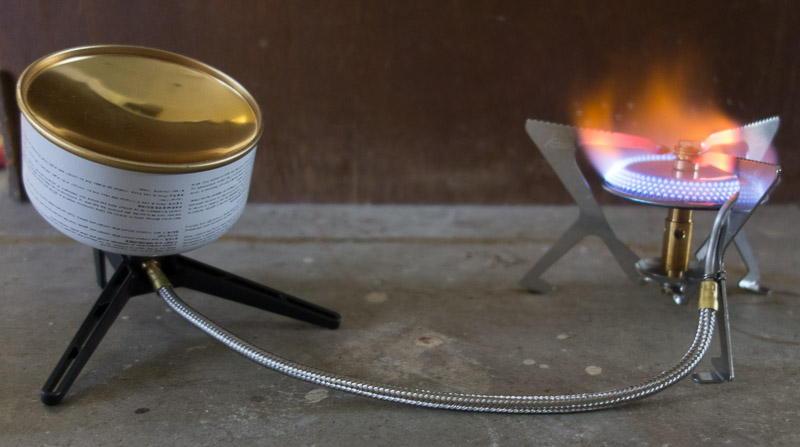
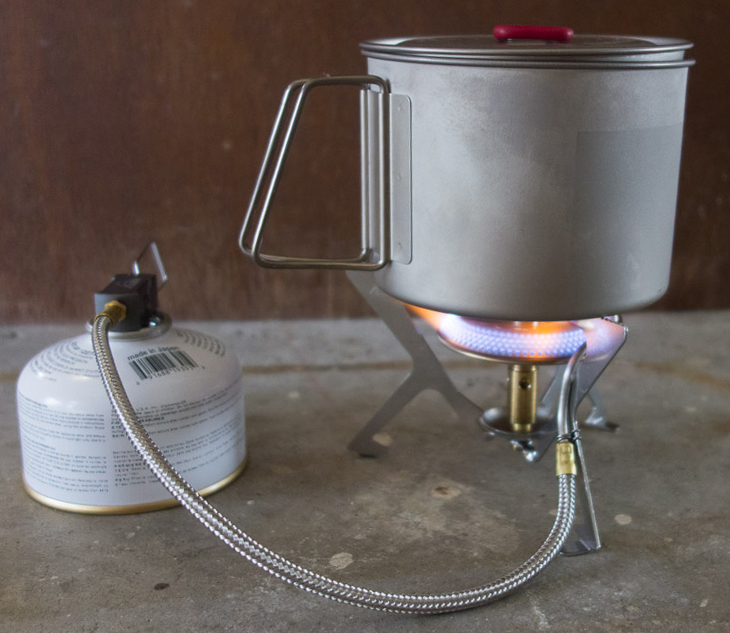
Summary
Canister stoves have the highest BTU rating, are easy to light and operate, and don’t flare-up like liquid-fueled stoves (unless you try to light them with the canister inverted). For inverted use, light it with the canister in the upright position, turn the flame to low, inverted the canister and adjust the flame down. Canister fuel is expensive and it is not easy to determine how much fuel remains in the canister.
INTEGRATED CANISTER SYSTEMS
These are top mounted canister stoves with special windscreens, heat exchanger pots, and accessories. I have never owned one. Most can only boil water and you must use the accessories made by the manufacturer. Most work down to about 20F.
Summary
Can’t really cook with one (although some people have done it), high fuel cost, works well in wind, and is the most efficient canister stove. Hard to determine how much fuel is in the canister when you are on the trail.
ALCOHOL STOVES
Alcohol is cheap and easily available. Alcohol stoves can be made using aluminum cans or you can purchase one. The BTUs are much lower than liquid or gas. It is difficult to see the flame when using these stoves during the day. Many can be easily overturned and are often banned in areas of high fire danger. Many forest fires have been caused by hikers using these stoves. Without some very specialized techniques and accessories they cannot cook food. These are best used to just boil water. But they are among the lightest stove set-ups you can carry. Because of the lower BTU, you need to carry more fuel to operate than a liquid or canister stove.
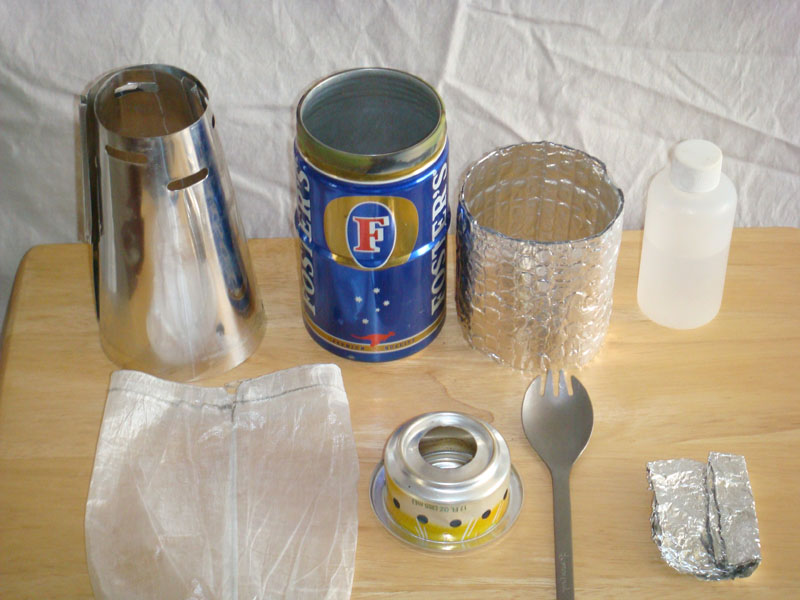
In my opinion the most efficient and safest alcohol systems are made by Trail Designs and are known as the Caldera Cone Stove System. They can be order to fit dozens of pots or even a recycled Fosters or Heineken beer can. The Caldera Cone System is the only alcohol stove I use. But I rarely use it anymore, as my Caldera Cone can also use Esbit solid fuel cubes, which I prefer.
Summary
Cheap fuel and easy to locate. Takes about twice as long to boil water as a liquid or canister stove. Lightweight.
SOLID FUEL STOVES
The most common solid fuel is Esbit brand cubes (hexamine). A 0.5 ounce cube can boil two cups of water. It is light and efficient. When burning is smells like fish, which is not a good thing in bear country. It leaves a residue on the pot. More BTU’s than alcohol but less than liquid or gas. It is the most expensive fuel of all. An Esbit system is the lightest stove system you can buy. My Trail Designs Caldera GVP system in Esbit mode with a beer can pot only weighs 2.96 ounces!
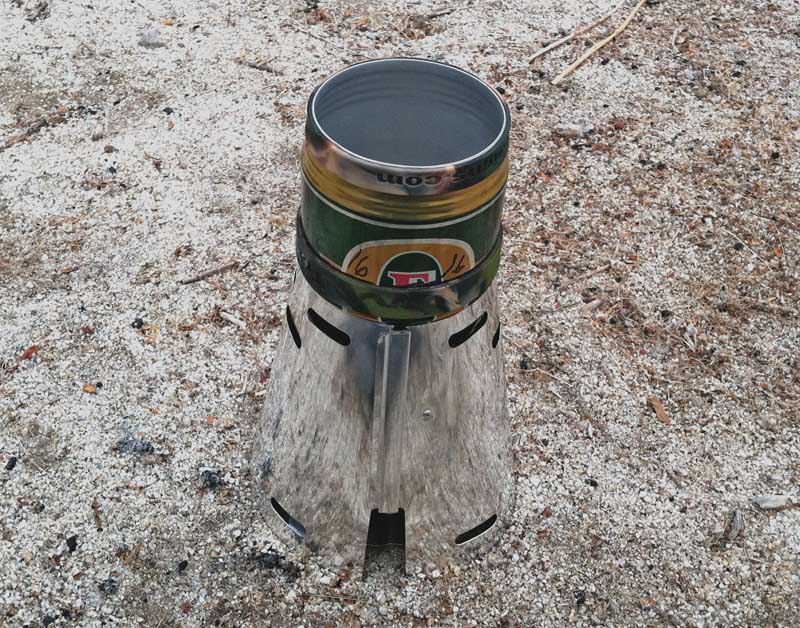
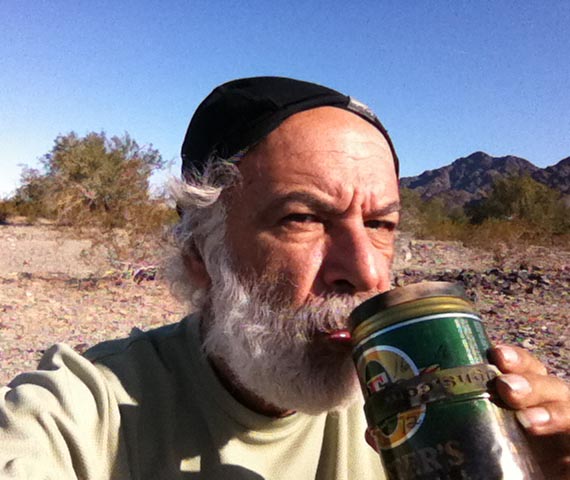
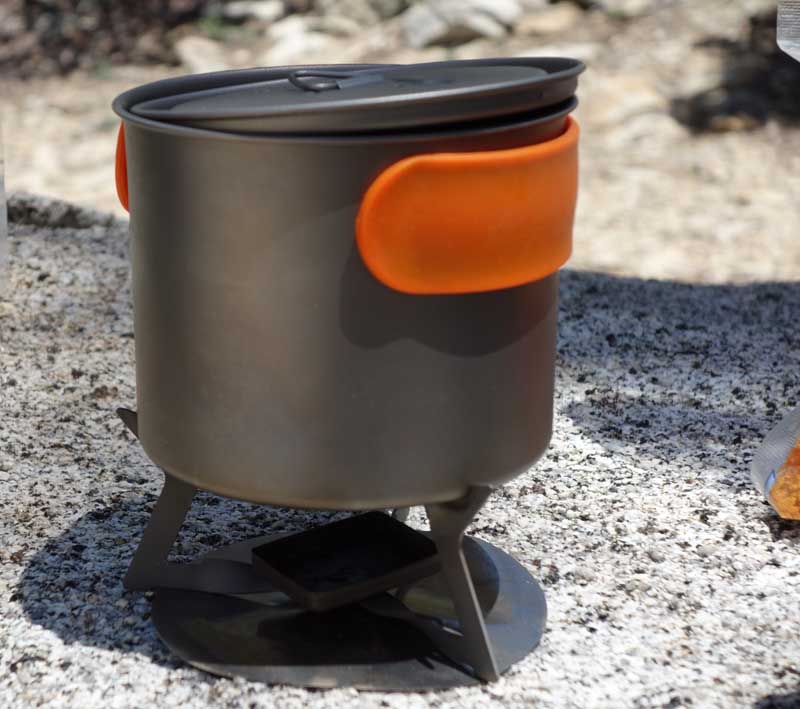
For more on the Caldera Esbit System versus the Lite Trail Esbit System.
STOVE WEIGHTS (APPROXIMATE) AND DOES NOT INCLUDE THE WEIGHT OF FUEL CONTAINERS
STOVE FUEL COSTS
FUEL COSTS
WHICH STOVE SHOULD YOU BUY?
Many people spend their lives trying to figure out which stove is the lightest. You can see that alcohol and Esbit are the lightest. But over time, the extra fuel required for alcohol begins to make the system heavier that a lightweight canister system. Then people try to figure out their cost per day, and blah, blah blah. Just pick a freaking stove or two and use them!
If I could only own just one stove, it would probably be the WindPro Universal. It runs on gas canisters and most liquid fuels. It works well in most winter situations. But the stove is one of the most expensive on the market.
WHAT I USE
On most 3 season trips it is
- Esbit about 90% of the time, using always the Trail Designs Caldera Cone GVP.
- If I need to purchase fuel in the middle of a trip it is an alcohol stove with my Trail Designs Caldera Cone GVP.
- If I need to actually cook something it is a Snow Peak Giga Power.
In winter it is
- WindPro II for most trips.
- If it is below 20F or a lot of snow melting for water is required, I prefer the MSR DragonFly.
If you are interested more in the evolution of stoves and my journey with them, you might be interested in my Vintage Stoves.
If you are a geek and want to learn everything about stoves, go to the Zen Stove website — but set aside a couple days to read it. This is the most comprehensive and accurate source about stove on the World Wide Web.
